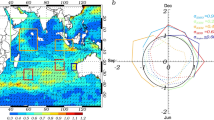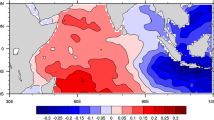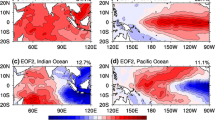Abstract
The El Niño-Southern Oscillation (ENSO) phenomenon in the tropical Pacific has been a focus of ocean and climate studies in the last few decades. Recently, the short-term climate variability in the tropical Indian Ocean has attracted increasingly more attention, especially with the proposition of the Indian Ocean Dipole (IOD) mode. However, these phenomena are often studied separately without much consideration of their interaction. Observations reveal a striking out-of-phase relationship between zonal gradients of sea surface height anomaly (SSHA) and sea surface temperature anomaly (SSTA) in the tropical Indian and Pacific Oceans. Since the two oceans share the ascending branch of the Walker cells over the warm pool, the variation within one of them will affect the other. The accompanied zonal surface wind anomalies are always opposite over the two basins, thus producing a tripole structure with opposite zonal gradients of SSHA/SSTA in the two oceans. This mode of variability has been referred to as Indo-Pacific Tripole (IPT). Based on observational data analyses and a simple ocean-atmosphere coupled model, this study tries to identify the characteristics and physical mechanism of IPT with a particular emphasis on the relationships among ENSO, IOD, and IPT. The model includes the basic oceanic and atmospheric variables and the feedbacks between them, and takes into account the inter-basin connection through an atmospheric bridge, thus providing a valuable framework for further research on the short-term tropical climate variability.
Similar content being viewed by others
References
Allan R J, Chambers D, Drosdowsky W, et al. 2001. Is there an Indian Ocean dipole, and is it independent of the El Niño-Southern Oscillation?. CLIVAR Exch, 6: 18–22
Anderson D. 1999. Extremes in the Indian Ocean. Nature, 401: 327–328
Ashok K, K, Guan Z, Yamagata T. 2001. Impact of the Indian Ocean dipole on the relationship between the Indian Monsoon rainfall and ENSO. Geophys Res Lett, 28: 4499–4502
Ashok K, Behera S K, Rao S A, et al. 2007. El Niño Modoki and its possible teleconnection. J Geophys Res, 112: C11007, doi: 10.1029/2006JC003798
Behringer D W, Xue Y. 2004. Evaluation of the global ocean data assimilation system at NCEP: The Pacific Ocean. Preprints, Eighth Symp. on Integrated Observing and Assimilation Systems for Atmosphere, Oceans, and Land Surface, Seattle, WA. Amer Meteor Soc, 2.3
Bjerknes J. 1969. Atmospheric tele-connections from the equatorial Pacific. Mon Wea Rev, 97: 163–172
Carton J A, Chepurin G, Cao X, et al. 2000a. A Simple Ocean Data Assimilation analysis of the global upper ocean 1950–1995, Part 1: Methodology. J Phys Oceanogr, 30: 294–309
Carton J A, Chepurin G, Cao X, 2000b. A Simple Ocean Data Assimilation analysis of the global upper ocean 1950–1995, Part 2: Results. J Phys Oceanogr, 30: 311–326
Chang C P, Li T. 2000. A theory for the tropical tropospheric biennial oscillation. J Atmos Sci, 57: 2209–2224
Chen D, Cane M A. 2008. El Niño prediction and predictability. J Comput Phys, 227: 3625–3640
Chen D. 2011. Indo-Pacific Tripole: An intrinsic mode of tropical climate variability. Adv Geosci, 24: 1–18
Chen D, Busalacchi A J, Rothstein L M. 1994. The Roles of vertical mixing, solar radiation and wind stress in a model simulation of the tropical Pacific seasonal cycle. J Geophys Res, 99: 20345–20359
Ducet N, Le Traon P Y, Reverdin G. 2000. Global high resolution mapping of ocean circulation from TOPEX/Poseidon and ERS-1 and -2. J Geophys Res, 105: 19477–19498
Gill A E. 1980. Some simple solutions for heat-induced tropical circulation. Quart J Roy Meteor Soc, 106: 447–462
Hastenrath S. 2002. Dipoles, temperature gradients, and tropical climate anomalies. Bull Amer Meteor Soc, 83: 735–738
Jin F F. 1997a. An equatorial ocean recharge paradigm for ENSO. Part I: Conceptual model. J Atmos Sci, 54: 811–829
Jin F F. 1997b. An equatorial ocean recharge paradigm for ENSO. Part II: A stripped-down coupled model. J Atmos Sci, 54: 830–847
Kalnay E, Kanamitsu M, Kistler R, et al. 1996. The NCEP/NCAR 40-year Reanalysis Project. Bull Amer Meteor Soc, 77: 437–472
Kug J S, Jin F F, An S I. 2009. Two types of El Niño events: Cold tongue El Niño and warm pool El Niño. J Clim, 22: 1499–1515
Levitus S, Gelfeld R. 1992. NODC Inventory of Physical Oceanographic Profiles, Key to Oceanographic Records Documentation. Washington DC: Natl Oceanic Data Cent. 18
Li T, Wang B, Chang C P, et al. 2003. A theory for the Indian Ocean dipolezonal mode. J Atmos Sci, 60: 2119–2135
Lian T, Chen D. 2012. An evaluation of rotated EOF analysis and its application to tropical Pacific SST variability. J Clim, 25: 5361–5373
Meyers G, Mcintosh P, Pigot L, et al. 2007. The years of El Niño, La Niña and interactions with the tropical Indian Ocean. J Clim, 20: 2872–2880
Nigam S, Shen H S. 1993. Structure of oceanic and atmospheric low-frequency variability over the tropical Pacific and Indian Oceans. Part I: COADS observations. J Clim, 6: 657–676
Nicholson S E. 1997. An analysis of the ENSO signal in the tropical Atlantic and western Indian Oceans. Intl J Climatol, 17: 345–375
Picaut J, Masia F, du Penhoat Y. 1997. An advective-reflective conceptual model for the oscillatory nature of the ENSO. Science, 277: 663–666
Rasmusson E M, Carpenter T H. 1982. Variations in tropical sea surface temperature and surface wind fields associated with the Southern Oscillation/El Niño. Mon Weather Rev, 110: 354–384
Rayner N A, Parker D E, Horton E B, et al. 2003. Global analyses of sea surface temperature, sea ice, and night marine air temperature since the late nineteenth century. J Geophys Res, 108: 4407, doi: 10.1029/2002JD002670
Sakova I, Meyers G A, Coleman R. 2006. Interannual variability in the Indian Ocean using altimeter and IX1-expendable bathy thermograph (XBT) data: Does the 18-month signal exist?. Geophy Res Lett, 33: 1–5
Saji N H, Goswami B N, Vinayachandran P N, et al. 1999. A dipole mode in the tropical Indian Ocean. Nature, 401: 360–363
Suarez M J, Schopf P S. 1988. A delayed action oscillator for ENSO. J Atmos Sci, 45: 3283–3287
Wang D P, Chen D, Sherwin T J. 1990. Coupling between mixing and advection in shallow sea front. Cont Shelf Res, 10: 123–136
Xie S P, Annamalai H, Schott F A, et al. 2002. Structure and mechanisms of South Indian Ocean climate variability. J Clim, 15: 864–878
Yamagata T, Behera S K, Rao S A, et al. 2003. The Indian Ocean Dipole: A physical mode. Bull Am Meteorol Soc, 84: 1418–1422
Yeh S W, Kug J S, Dewitte B, et al. 2009. El Niño in a changing climate. Nature, 461: 511–514
Yu J Y, Kim S T. 2010. Three evolution, patterns of central Pacific El Niño. Geophys Res Lett, 37: L08706, doi: 10.1029/2010GL042810
Yu L, Rienecker M M. 1999. Mechanisms for the Indian Ocean warming during 1997–98 El Niño. Geophys Res Lett, 26: 735–738
Zebiak S, Cane M A. 1987. A model El Niño-Southern Oscillation. Mon Weather Rev, 115: 2262–2278
Zhou L, Murtugudde R, Jochum M. 2008. Seasonal influence of Indonesian Throughflow in the southwestern Indian Ocean. J Phys Oceanogr, 38: 1529–1541
Author information
Authors and Affiliations
Corresponding author
Rights and permissions
About this article
Cite this article
Lian, T., Chen, D., Tang, Y. et al. A theoretical investigation of the tropical Indo-Pacific tripole mode. Sci. China Earth Sci. 57, 174–188 (2014). https://doi.org/10.1007/s11430-013-4762-7
Received:
Accepted:
Published:
Issue Date:
DOI: https://doi.org/10.1007/s11430-013-4762-7




